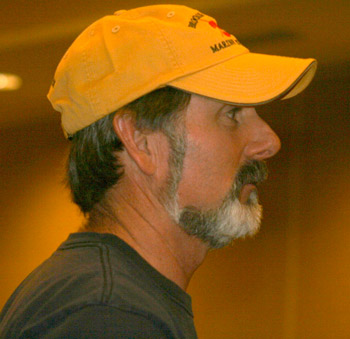“Possiblity Open”
continued from Homepage

Fisherman Stanley “Cappy” Sargent. “If you close all that area down, that’s a huge portion of the Gulf of Maine.” Laurie Schreiber photo
DMR Director of External Affairs Terry Stockwell, who is also NEFMC’s chairman, said that, to date, NEFMC has received more than 100,000 written comments, mostly form letters, on the amendment. “They’re coming in by the armload every day,” Stockwell said.
Stockwell urged fishermen to attend NEFMC public hearings on the amendment. One will be held Monday, Jan. 5 via webinar. Register at http://bit.ly/1yDgJux. A summary document can be found at here.![]() In Maine, there will be public hearings on Tuesday, Jan. 6 at 6 p.m. at Jeff’s Catering and Event Center in Brewer; and Wednesday, Jan. 7 at 6 p.m. at the Holiday Inn by the Bay in Portland.
In Maine, there will be public hearings on Tuesday, Jan. 6 at 6 p.m. at Jeff’s Catering and Event Center in Brewer; and Wednesday, Jan. 7 at 6 p.m. at the Holiday Inn by the Bay in Portland.
The amendment includes proposals for area closures for habitat protection, groundfish spawning, and research. Implications include the possibility of closures for the scallop, quahog, halibut, shrimp, herring and groundfish fisheries; the amendment could impact Maine fishermen who operate in federal waters.
In the Gulf of Maine, alternatives consist of two types of year-round closures: habitat closures areas that would ban mobile bottom-tending gear; and groundfish closures, which would exclude gears capable of catching groundfish, including mobile bottom-tending gears.
The proposals include a variety of configurations to mix and match, including the type of closures, the size of the areas to be closed, and gear exemptions or modifications.
Stockwell said NEFMC was originally scheduled to take a final vote on the measures in January 2015. But it’s unlikely public comments and analysis will take place in time. The earliest the NEFMC is likely to vote on the amendment is autumn 2015, with implementation in 2016, he said.
Area and season closures are already in place, or on the horizon, under individual fishery management plans. NEFMC is considering broad cod protection closures in the Gulf of Maine for the 2015 fishing year, and NEFMC will be considering a report on the protection of deep-seas corals.
The status of exempted gear and fisheries under individual plan closures is under review.“The stability of their definition is somewhat in question,” said DMR deputy commissioner Meredith Mendelson. “The overall takeaway is, it’s going to evolve. It’s going to be in flux, and it’s something we need to keep an eye on and have people weighing in on as it does evolve.”
Stockwell said the short-term impact of the amendment on Maine’s lobster fishery is “negligible.” But, he added, “the long-term impact is unknown.” NEFMC plans to work with the Atlantic States Marine Fisheries Commission, NOAA’s Northeast Fisheries Science Center and the coastal states in the Northeast on the question of cod bycatch in lobster traps; there has been little information to date.
Overall, Stockwell said, it’s important to keep in mind that, once closures are established, “they’re going to be in place for a lot of your collective fishing years. For instance, purse seines are a gear capable of catching groundfish, but they’re also an exempt fishery for now. Midwater trawls are in the same category. But there are some members of the council who want to revisit that. So we need to look, not just the next year, but five or ten years down the road.”
